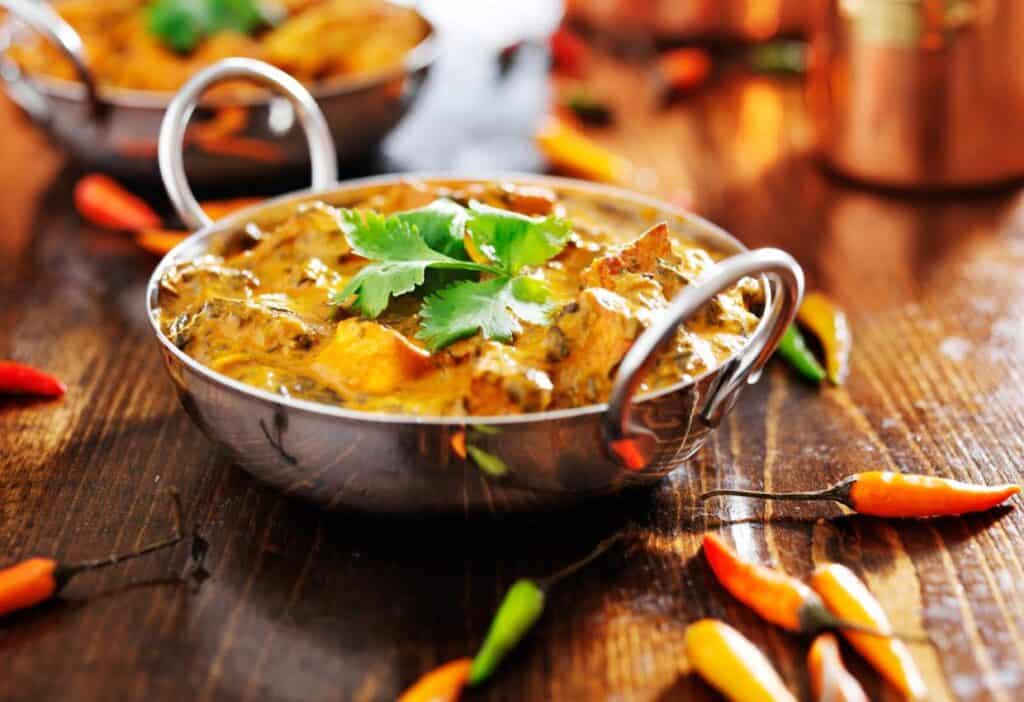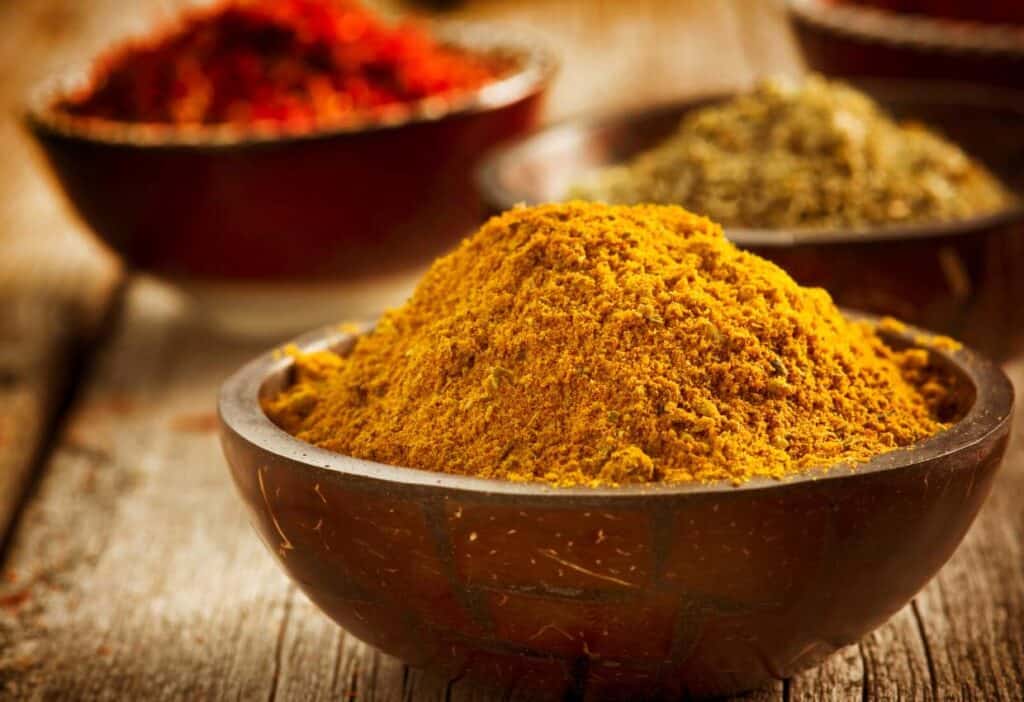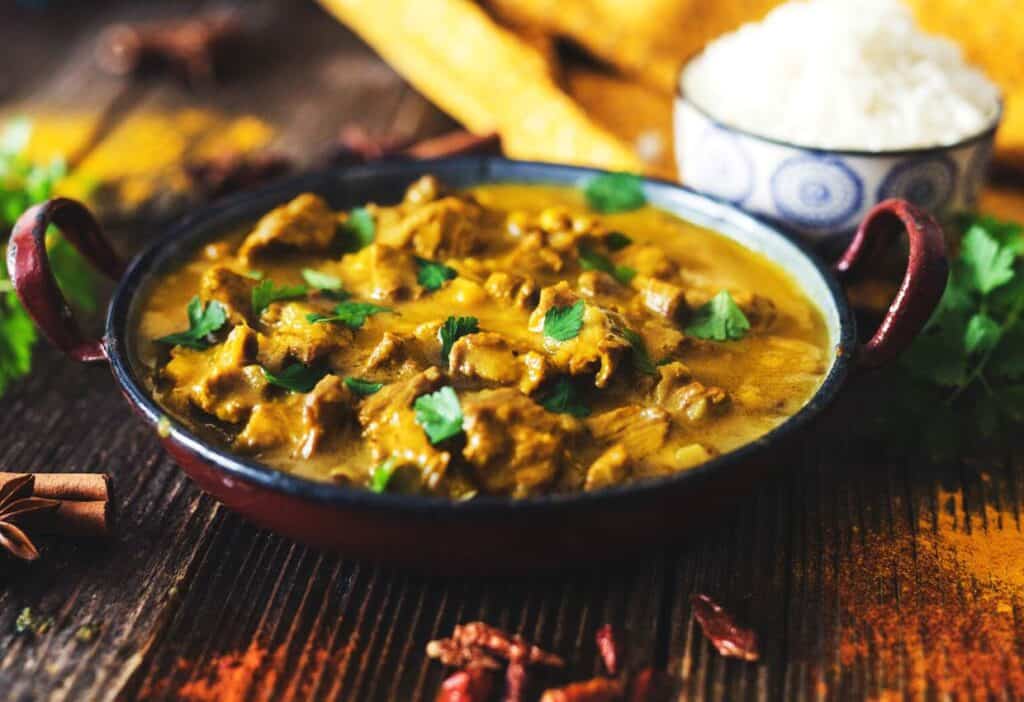Curry is a beloved dish in many different cuisines that span the globe. Here is a primer on the various types of curry, common curry ingredients, and their unique flavor profiles from region to region.

What Is Curry?
Curry is a dish that has captured the hearts and palates of people worldwide. The term “curry,” first coined by the British, refers to a variety of dishes that typically consist of meat, fish, vegetables, or legumes cooked with a mixture of spices, herbs, and sometimes heavy cream or coconut milk. The exact combination of ingredients varies from region to region, giving rise to a diverse range of curry dishes.
Common Curry Ingredients
Here are some of the most common ingredients used in curry recipes, including their unique flavor profiles and special uses.
Spices
Spices are an essential component of curries and give them distinct and complex flavors. Here are spices commonly used in curries:
Turmeric: A bright yellow spice that gives curries both vibrant color and an earthy flavor.
Cumin: Cumin is a warm, peppery seed that adds aroma and flavor to curry.
Coriander: Coriander has an almost citrusy flavor and is often used to balance the flavors and bring a bit of brightness.
Garam masala: Garam masala is a blend of spices commonly used in Indian curries. The combination varies from region to region but often includes cinnamon, cardamom, and cloves, among others. It adds warmth and depth to curries.
Ginger: Both dried and fresh forms of ginger add warmth and a bit of sharpness.
Mustard seed: Mustard seeds often give curries zest and a slight bitterness that brings balance.
FDL’S 75 Best Bites

Our cookbook with 75 tasty recipes will be your go-to kitchen companion for easy dinners with ad-free recipes right at your fingertips. Crafted by experienced chefs and recipe developers, this collection offers a treasure trove of tried-and-true dishes that make mealtime a breeze.
Get the Recipe: FDL’S 75 Best Bites
Herbs
Herbs are another critical component of curries and add flavor and freshness to the dish. Here are some common herbs used in curries:
Curry leaves: A highly fragrant herb common in South Indian curries for its distinct, almost nutty flavor.
Cilantro: Cilantro is a citrusy herb that adds brightness and freshness.
Mint: A cooling and refreshing herb that balances the heat in spicier curries.
Basil: A sweet and slightly spicy herb that adds a unique flavor to add depth.
Vegetables
Vegetables are essential to many curries, providing texture, flavor, and nutrients. Here are some vegetables you’ll often find in curries:
Onions: A staple ingredient in many dishes and cuisines, sauteed onions serve as a base in most curry dishes to add sweetness and depth of flavor.
Tomatoes: A common ingredient in many curries, tomatoes add a touch of acidity.
Potatoes: The starchiness of potatoes is useful in curries to provide texture and bulk.
Eggplant: Eggplant curries are especially common in Indian cuisine, as eggplant adds a unique texture and taste.
Spinach: Spinach can add mild flavor and nutrients.
Meat
Meat is a common ingredient in many curries, providing protein and a rich, savory flavor. Here are some common types of meat used in curries:
Chicken: A versatile meat, chicken works in both mild and spicy dishes.
Lamb: Lamb is a flavorful and tender meat that works well in richer and spicier curry dishes, such as keema matar.
Beef: Hearty and rich, beef works well in curries with strong and bold flavors.
Fish: Due to its light and delicate nature, fish works best with milder flavors.

Types of Curry
Curries differ wildly from one part of the world to another. Here are some of the most common types of curry from different cuisines and what makes each distinctive and delicious.
Indian Curry
Indian cuisine is known for its rich and flavorful curries, typically made with a blend of spices and herbs, including cumin, coriander, turmeric, and garam masala. Here are some popular types of Indian curries:
Butter chicken: Butter chicken is a super creamy curry with marinated chicken pieces in tomato sauce.
Rogan josh: Rogan josh is a rich and spicy meat-based curry with roots in Kashmiri cuisine.
Chana masala: Chana masala is a vegetarian chickpea curry with chickpeas, tomatoes, and a unique blend of spices.
Vindaloo: With origins in Goan cuisine, this spicy and tangy curry combines marinated meat and a blend of spices and vinegar.
“I traveled on a rice boat in Kerala and we had our own chef. With just a one-ring portable gas stove and one pan, he created the most aromatic and delicious curry I had ever tasted. It just shows that you don’t have to have fancy equipment, you just need to know how to blend the spices.” — Mandy Applegate, Splash of Taste
Thai Curry
Thai cuisine is known for its aromatic and spicy curries, often including herbs and spices like lemongrass, galangal, and makrut lime leaves. Here are some popular types of Thai curries:
Green curry: Thai green curry is a fragrant curry with a base made with green chiles, lemongrass, and makrut lime leaves.
Panang curry: Panang curry is a creamy, mildly spiced curry typically made with peanut butter and coconut milk.
Massaman curry: A rich and flavorful curry often made with coconut milk, potatoes, peanuts, and a blend of spices.
“I love Thai curries because the flavors are so fresh and intense. Ingredients like lemongrass, galangal, makrut lime leaves, fresh chiles, and fresh herbs give it perfect balance, but also a unique brightness. You can add any protein or veggies you like and make it into a delicious and nourishing meal.” — Robin Donovan, All Ways Delicious
Japanese Curry
Japanese curry offers a unique fusion of flavors from Japan and India, often including curry powder, ginger, and mint. Here are some popular types of Japanese curries:
Katsu curry: Katsu curry consists of breaded and fried chicken or pork cutlet in a creamy sauce base.
Kuro curry: Also known as black curry, kuro curry is similar to a katsu curry but with the addition of dark-colored ingredients like squid ink and chocolate.
Malaysian Curry
Malaysian curry takes on flavors from Malaysia, China, and India and is often made with curry powder, lemongrass, and tomatoes. Here are some popular types of Malaysian curries:
Beef rendang: A spicy beef curry slow-cooked with coconut milk and a blend of spices.
Curry laksa: Laksa is a noodle soup made with a fragrant curry broth.

Sri Lankan Curry
Sri Lankan cuisine is known for its spicy and flavorful curries, typically made with curry leaves, cumin, coriander, and coconut milk. Here are some popular types of Sri Lankan curries:
Sri Lankan Egg Curry: Sri Lankan Egg Curry is a mild curry made with hard-boiled eggs, fish flakes, and coconut milk.
Kukul Mas: This Sri Lankan chicken curry usually consists of curry in a rich coconut milk base spiced with coriander, mustard, and fennel.
Indonesian Curry
An Indonesian curry is often made with coconut milk, fish sauce, and tamarind paste. Here are some popular types of Indonesian curries:
Gulai Ayam: Also known as Padang curry chicken, this curry usually includes makrut lime leaves, tamarind, and lemongrass.
Sayur Lodeh: This Javanese curry sometimes includes ingredients like tofu, tempeh, and jackfruit, in a mild coconut milk base.
Caribbean Curry
Caribbean cuisine is known for spicy and flavorful curries, typically made with spices and herbs, including allspice, thyme, and scotch bonnet peppers. Here are some popular types of Caribbean curries:
Goat curry: Common in Jamaican cuisine, goat curry is a spicy curry made with goat meat and a blend of spices that often includes allspice and thyme.
Pork Colombo: A rich pork curry with roots in Martinique that includes unique ingredients not typically seen in a curry, like mango, wine, and chayotes.
Ethiopian Curry
Ethiopian curries are known for their unique blend of spices and flavors, which often includes berbere, garlic, and ginger. Here are some popular types of Ethiopian curries:
Doro wat: A spicy chicken curry typically made with berbere, butter, ginger, and chicken thighs.
Misir wat: Misir wat is a red lentil curry often made with a blend of berbere and cumin.
Korean Curry
Korean curry is a fusion of flavors from Korea and Japan and usually includes the addition of Korean curry powder, and sometimes even gochujang. Korean curry powder usually contains fenugreek, turmeric, and cumin. Here is a popular type of Korean curry:
Curry rice: Korean curry rice is a meat and vegetable curry served over rice.
Afghan Curry
Afghan cuisine combines Middle Eastern, Central Asian, and South Asian flavors. It is common for most Afghan curries to include beans. Here are some popular types of Afghan curries:
Ghorma: A curry often made with chicken or beef, tomatoes, and potatoes.
Lubya: Lubya is a kidney bean-based curry commonly made with mint, cumin, and tomatoes.
“If you truly want to make a good curry, whether it’s Indian or Thai or another cuisine, don’t buy curry powder. Make your own mix and be sure to use the freshest spices you can find, as it really makes a difference between a good curry and a great curry.” — Michelle Price, Honest and Truly
British Curry
British curry is a unique style of curry that has developed in the United Kingdom over the years, taking on inspiration from Indian cuisines. Here are some popular types of British curries:
Chicken tikka masala: While the origins of this dish remain in Indian cuisine, this dish is so popular in Britain that some call it an authentically British dish. Chicken tikka masala is a curry dish consisting of chicken marinated in yogurt and spices before being cooked in a tomato-based sauce, this goes great with Indian mint sauce.
Madras curry: Madras curry is a meat and tomatoes-based curry that tends to be on the spicier side of the heat spectrum.
A Note on Fusion Curries
Fusion curries are a modern take on traditional curries, where chefs incorporate ingredients and flavors from different cuisines to create unique and exciting dishes. For example, a Mexican chicken curry blended with Mexican and Indian spices or an Italian-style beef curry served over pasta instead of the typical rice.
Fusion curries can be an excellent way to enjoy the flavors of different cultures and cuisines while also learning new about ingredients and techniques in the kitchen.
Wrapping Up Our Journey
Curries are an absolute culinary journey, transporting you around the globe in each bite. From the spicy and complex curries of South Asia to the milder and creamier curries of the UK, endless variations of this special dish have evolved over time.
There’s no doubt that curries offer an incredibly diverse selection of distinct flavors, textures, and spice levels to be found the world over.
Curries incorporate a vast array of spices, herbs, vegetables, and meats, and this diversity is one of the reasons why curry dishes are so incredibly popular.
So next time you’re looking for a delicious and satisfying meal, consider trying a new curry recipe and experience the rich and complex flavors this beautiful dish offers.
Kristen Wood is a photographer, writer, and creator of the food blog MOON and spoon and yum. She is also the author of Vegetarian Family Cookbook, Fermented Hot Sauce Cookbook, and Hot Sauce Cookbook for Beginners. Her work has been featured in various online and print publications, including Elle, Martha Stewart, Yoga Journal, and more.